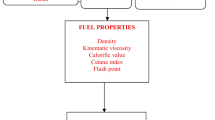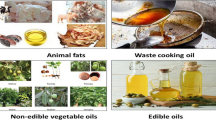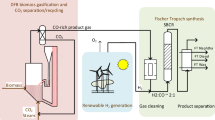Abstract
The present experimental investigation aims at production of second-generation biofuels from straight vegetable oils (SVOs) and carrying out their performance assessment in a compression ignition (CI) engine. The intended second-generation biofuels, i.e., deoxygenated vegetable oils (DVOs), were produced through catalytic deoxygenation of palm and karanja SVOs over 5 wt% Pd/C catalyst under an inert (N2) atmosphere using a batch autoclave reactor. Fuel characterization and elemental analysis were carried out for the produced DVOs to evaluate various fuel properties. In order to evaluate the fuel composition and presence of diesel range aliphatic hydrocarbons, GC-MS and FT-NMR tests were carried out. The engine performance and emission characteristics with the DVOs were evaluated in a developed experimental diesel engine setup. Results showed that the DVOs exhibit better engine performance, lower emissions, and marginally higher NOx emissions compared to those with diesel fuel. In order to establish the DVOs as possible CI engine fuels, the performance and emission characteristics with the DVOs were compared against those with their corresponding established B20 biodiesel blends. The comparative assessment revealed that the engine performance and emission characteristics with the DVOs are superior compared to those with the corresponding B20 biodiesel blends. Especially, the NOx emissions with the DVOs are significantly lower as compared to their corresponding B20 biodiesel blends.




Similar content being viewed by others
References
Hajjari M, Tabatabaei M, Aghbashlo M, Ghanavati H (2017) A review on the prospects of sustainable biodiesel production: a global scenario with an emphasis on waste-oil biodiesel utilization. Renew Sust Energ Rev 72:445–464
Deep A, Sandhu SS, Chander S (2017) Experimental investigations on the influence of fuel injection timing and pressure on single cylinder CI engine fueled with 20% blend of castor biodiesel in diesel. Fuel 210:15–22
Pattanaik BP, Misra RD (2017) Effect of reaction pathway and operating parameters on the deoxygenation of vegetable oils to produce diesel range hydrocarbon fuels: a review. Renew Sust Energ Rev 73:545–557
Singh D, Sandhu SS, Sarma AK (2018) An investigation of green diesel produced through hydro-processing of waste cooking oil using an admixture of two heterogeneous catalysts. Energy Sources, Part A 40:968–976
Naik SN, Goud VV, Rout PK, Dalai AK (2010) Production of first and second generation biofuels: a comprehensive review. Renew Sust Energ Rev 14:578–597
No SY (2014) Application of hydrotreated vegetable oil from triglyceride based biomass to CI engines–a review. Fuel 115:88–96
Erkkilä K, Nylund NO, Hulkkonen T, Tilli A, Mikkonen S, Saikkonen P, Makinen R, Amberla A (2011) Emission performance of paraffinic HVO diesel fuel in heavy duty vehicles. SAE Technical Paper No 2011-01-1966
Pflaum H, Hofmann P, Geringer B, Weissel W (2010) Potential of hydrogenated vegetable oil (HVO) in a modern diesel engine. SAE Technical Paper No. 2010-32-0081
Murtonen T, Aakko-Saksa P, Kuronen M, Mikkonen S, Lehtoranta K (2010) Emissions with heavy-duty diesel engines and vehicles using FAME, HVO and GTL fuels with and without DOC+ POC aftertreatment. SAE Int J Fuels Lubr 2:147–166
Hermida L, Abdullah AZ, Mohamed AR (2015) Deoxygenation of fatty acid to produce diesel-like hydrocarbons: a review of process conditions, reaction kinetics and mechanism. Renew Sust Energ Rev 42:1223–1233
Yenumala SR, Maity SK, Shee D (2016) Hydrodeoxygenation of karanja oil over supported nickel catalysts: influence of support and nickel loading. Catal Sci Technol 6:3156–3165
Romero MJ, Pizzi A, Toscano G, Bosio B, Arato E (2016) Deoxygenation of waste cooking oil and non-edible oil for the production of liquid hydrocarbon biofuels. Waste Manag 47:62–68
Gosselink RW, Hollak SA, Chang SW, van Haveren J, de Jong KP, Bitter JH, van Es DS (2013) Reaction pathways for the deoxygenation of vegetable oils and related model compounds. ChemSusChem 6:1576–1594
Santillan-Jimenez E, Crocker M (2012) Catalytic deoxygenation of fatty acids and their derivatives to hydrocarbon fuels via decarboxylation/decarbonylation. J Chem Technol Biotechnol 87:1041–1050
Domínguez-Barroso MV, Herrera C, Larrubia MA, Alemany LJ (2016) Diesel oil-like hydrocarbon production from vegetable oil in a single process over Pt–Ni/Al2O3 and Pd/C combined catalysts. Fuel Process Technol 148:110–116
Raut R, Banakar VV, Darbha S (2016) Catalytic decarboxylation of non-edible oils over three-dimensional, mesoporous silica-supported Pd. J Mol Catal A Chem 417:126–134
de Sousa FP, Cardoso CC, Pasa VM (2016) Producing hydrocarbons for green diesel and jet fuel formulation from palm kernel fat over Pd/C. Fuel Process Technol 143:35–42
Santillan-Jimenez E, Pace R, Marques S, Morgan T, McKelphin C, Mobley J, Crocker M (2016) Extraction, characterization, purification and catalytic upgrading of algae lipids to fuel-like hydrocarbons. Fuel 180:668–678
Xue J, Grift TE, Hansen AC (2011) Effect of biodiesel on engine performances and emissions. Renew Sust Energ Rev 15:1098–1116
Enweremadu CC, Rutto HL (2010) Combustion, emission and engine performance characteristics of used cooking oil biodiesel—a review. Renew Sust Energ Rev 14:2863–2873
Sayin C, Gumus M (2011) Impact of compression ratio and injection parameters on the performance and emissions of a DI diesel engine fueled with biodiesel-blended diesel fuel. Appl Therm Eng 31:3182–3188
Palash SM, Kalam MA, Masjuki HH, Masum BM, Fattah IR, Mofijur M (2013) Impacts of biodiesel combustion on NOx emissions and their reduction approaches. Renew Sust Energ Rev 23:473–490
Reşitoğlu İA, Keskin A (2017) Biodiesel production from free fatty acids and the effects of its blends with alcohol–diesel on engine characteristics. Clean Techn Environ Policy 19:925–931
Hoekman SK, Robbins C (2012) Review of the effects of biodiesel on NOx emissions. Fuel Process Technol 96:237–249
Fazal MA, Haseeb ASMA, Masjuki HH (2011) Biodiesel feasibility study: an evaluation of material compatibility; performance; emission and engine durability. Renew Sust Energ Rev 15:1314–1324
Fattah IR, Masjuki HH, Kalam MA, Mofijur M, Abedin MJ (2014) Effect of antioxidant on the performance and emission characteristics of a diesel engine fueled with palm biodiesel blends. Energy Convers Manag 79:265–272
Vedaraman N, Puhan S, Nagarajan G, Velappan KC (2011) Preparation of palm oil biodiesel and effect of various additives on NOx emission reduction in B20: an experimental study. Int J Green Energy 8:383–397
Raheman H, Phadatare AG (2004) Diesel engine emissions and performance from blends of karanja methyl ester and diesel. Biomass Bioenergy 27:393–397
Canakci M, Hosoz M (2006) Energy and exergy analyses of a diesel engine fuelled with various biodiesels. Energy Sources, Part B 1:379–394
Lahane S, Subramanian KA (2015) Effect of different percentages of biodiesel–diesel blends on injection, spray, combustion, performance, and emission characteristics of a diesel engine. Fuel 139:537–545
Datta A, Mandal BK (2017) A numerical study on the performance, combustion and emission parameters of a compression ignition engine fuelled with diesel, palm stearin biodiesel and alcohol blends. Clean Techn Environ Policy 19:157–173
Dhar A, Agarwal AK (2014) Performance, emissions and combustion characteristics of Karanja biodiesel in a transportation engine. Fuel 119:70–80
Khalil I, Aziz AR, Yusup S, Heikal M, El-Adawy M (2017) Response surface methodology for the optimization of the production of rubber seed/palm oil biodiesel, IDI diesel engine performance, and emissions. Biomass Conv Bioref 7:37–49
Nayak SK, Mishra PC (2017) Application of neem biodiesel and dimethyl carbonate as alternative fuels. Energy Sources, Part A 39:284–290
Roy MM, Alawi M, Wang W (2013) Effects of canola biodiesel on a DI diesel engine performance and emissions. Int J Mech Eng 13:46–53
Agarwal AK, Srivastava DK, Dhar A, Maurya RK, Shukla PC, Singh AP (2013) Effect of fuel injection timing and pressure on combustion, emissions and performance characteristics of a single cylinder diesel engine. Fuel 111:374–383
Agblevor FA, Abdellaoui H, Halouani K, Beis SH (2017) Pyrolytic conversion of olive mill wastewater sludge to biofuels using red mud as catalyst. Int J Energy Power Eng 6:108–120
Author information
Authors and Affiliations
Corresponding author
Additional information
Publisher’s Note
Springer Nature remains neutral with regard to jurisdictional claims in published maps and institutional affiliations.
Rights and permissions
About this article
Cite this article
Pattanaik, B.P., Misra, R.D. Experimental studies on production of deoxygenated vegetable oils and their performance evaluation in a compression ignition engine. Biomass Conv. Bioref. 8, 899–908 (2018). https://doi.org/10.1007/s13399-018-0328-4
Received:
Revised:
Accepted:
Published:
Issue Date:
DOI: https://doi.org/10.1007/s13399-018-0328-4




